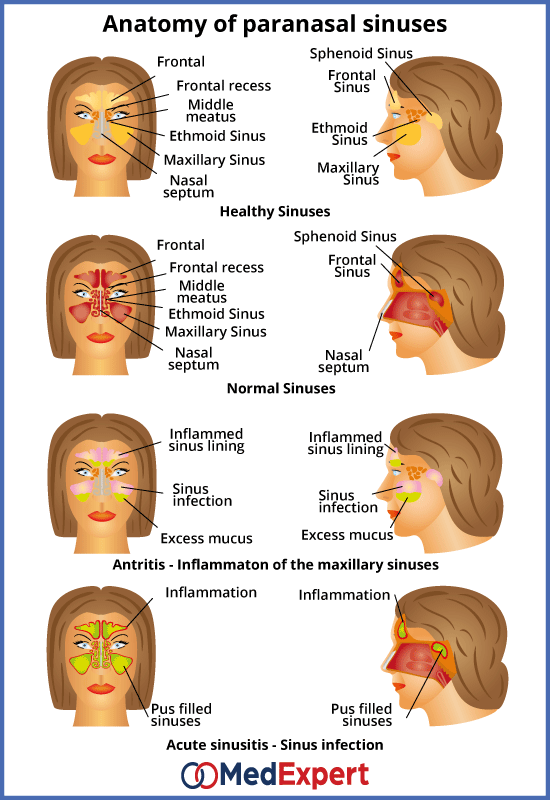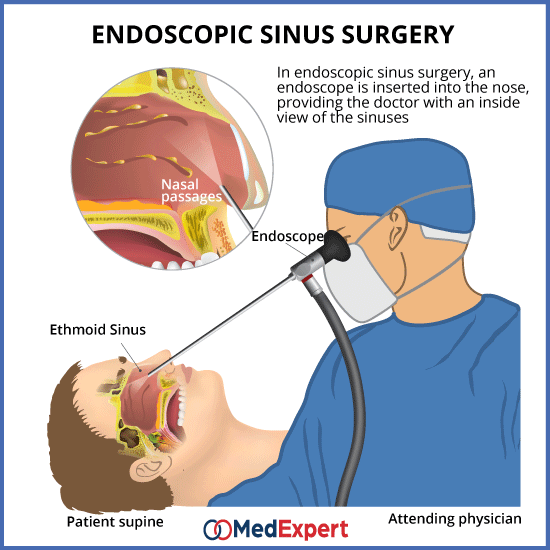SINUSITIS
Sinusitis is an inflammatory infection of paranasal sinuses. Sinusitis symptoms depend on the type of infection and severity of the inflammation. Sinusitis treatment includes both, conservative and surgical options. Below we will review in more detail sinusitis causes, types and treatment options.
This condition can be described as an inflammation or the swelling of tissues lining the sinuses. While sinuses get filled with air they could easily become filled and blocked with fluid along with bacteria, fungi and virus which can multiply and cause infection.

SINUSITIS CAUSES
Inflammatory infection of sinuses can come about from a variety of conditions which include common cold, nasal polyps (growths in the sinus lining), allergic rhinitis (swelling of the nasal lining) and deviated septum (shifting of the nasal cavity).
DO I NEED SINUS SURGERY?
- Acute: This type brings about symptoms like a runny, stuffy nose and sudden facial pains. These symptoms last up to 4 weeks
- Sub-acute: This type of sinus inflammation can last from 4 to 8 weeks
- Chronic: This sinusitis is a result of chronic inflammation which lasts for 8 weeks and longer
- Recurrent: This comes in several attacks within a year
SINUSITIS SYMPTOMS
Most common sinusitis symptoms include:
- Facial pains
- Nasal stiffness
- Nasal discharge
- Loss of smell
- Cough
- Fever
- Pus in the nasal cavity
- Bab breath
- Headaches
- Dental pain
It is considered that a person has an acute form of this disease, if he or she is experiencing two or more of the above symptoms or having green or yellow discharge from nose.
SINUSITIS TREATMENT OPTIONS
Treatment options available for sinusitis depend on the type of disease present:
- Acute form of inflammatory infection of sinuses: In the treatment of a simple sinus infection it is recommended to use a decongestant and steam inhalation. The use of over-the-counter decongestant should be limited to just a few days so as not to worsen the sinus congestion. The use of antibiotics prescribed the doctor takes 10 to 14 days in the treatment of acute sinusitis.
- Chronic Sinusitis: A number of methods can be applied in the treatment of chronic form of this disease, they include; inhalation of warm moist air from a vaporizer or steam from a bowl of warm water, use of a warm compress to ease pain in the nose and sinuses, use of saline nose drops. Antibiotics or steroids could also be prescribed by the doctor for certain conditions.
ARE THERE ANY OTHER OPTIONS OF SINUSITIS TREATMENT AVAILABLE?

In cases where medication treatment method fails, sinus surgery might be needed. The doctor might recommend surgery if there is a discovery of structural issues within the sinuses such as nasal polyps which hinder drainage. Daily activities can be resumed after 5 to 7 days of surgery and full recovery from 4 to 6 weeks.
DIAGNOSING SINUSITIS
- Physical examination: This is carried out by the doctor to consider the symptoms present so as to give diagnosis. This process involves the feeling and pressing of the sinuses to look for any tenderness and the tapping of the teeth to determine the presence of an inflamed paranasal sinus.
- Nasal Endoscopy: Nasoendoscopy is a minimally invasive, medical procedure carried out to diagnose any nasal conditions. It helps to examine the interior surfaces of the nose and allows visualization of its cavities not possible by standard examination.The procedure is performed with the help of a nasal endoscope which is a medical device consisting of a thin, rigid tube with fiberoptic cables to light-up the inside of the nose. The endoscope is then connected to a light source and a video camera to project magnified images on a screen. During the procedure your doctor may capture or record the images for further documentation.


